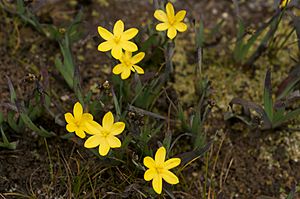Golden blue-eyed grass facts for kids
Quick facts for kids Golden blue-eyed grass |
|
|---|---|
 |
|
| Scientific classification | |
| Genus: |
Sisyrinchium
|
| Species: |
californicum
|
| Synonyms | |
|
List
|
|
The Sisyrinchium californicum is a cool flowering plant. It belongs to the iris family. People often call it golden blue-eyed grass or yellow-eyed-grass. It's not really a grass, but its leaves look like grass!
This plant grows naturally along the west coast of North America. You can find it from British Columbia in Canada all the way down to central California in the USA. It loves wet places, especially near the coast.
What Does Golden Blue-Eyed Grass Look Like?
This plant is a perennial, meaning it lives for more than two years. It grows from underground stems called rhizomes. These help it spread and grow new plants.
Stems and Leaves
The stems of the golden blue-eyed grass are a light green color. They are not waxy. They can grow quite tall, up to about 60 centimeters (about 2 feet). When the plant dries out, its stems and leaves turn a dark brown or black color. Its leaves are flat and narrow, just like blades of grass.
Flowers and Fruit
The flowers are bright yellow. Each flower has six petals, which are called tepals in plants like this. These tepals are usually between 1 and 2 centimeters long. You might notice brown lines or veins on the yellow petals. After the flower blooms, it produces a dark-colored fruit. This fruit is a small capsule that holds the seeds.

